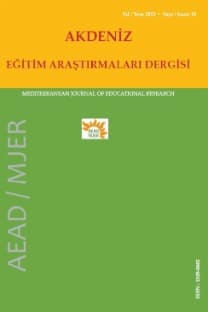Anaokuluna devam eden çocukların oyun davranışları ve oyunlarında ortaya çıkan zorbalık davranışlarının incelenmesi
Bu araştırmanın amacı; anaokuluna devam eden çocukların oyunları sırasında ortaya çıkan zorbalık ve oyun davranışlarını gözlem yöntemi tekniği kullanarak; cinsiyet, kardeş durumu ve okul öncesi eğitimi alma süresine göre farklılık gösterip göstermediğini tespit etmektir. Zorbalık ve oyun davranışlarının tespiti için Erken Çocukluk Dönemi Oyun ve Saldırganlık Gözlem Yöntemi geliştirilmiştir. Bu gözlem yönteminden elde edilen sonuçlara göre; fiziksel zorbalık davranış puanı yüksek olan çocukların fiziksel zorbalık davranışı, ilişkisel mağdur olma durumu, paralel oyun ve oyun dışı davranışlar cinsiyet değişkenine göre; sosyal yapı inşa oyun ise cinsiyet, kardeş durumu ve okul öncesi eğitimi alma süresinin ortak etkileşimine göre farklılaştığı tespit edilmiştir. Diğer bir yönden ise; ilişkisel zorbalık davranışı puanı yüksek olan çocukların ise fiziksel zorbalık davranışı, sosyal yapı inşa oyunu ve oyun dışı davranışlar cinsiyet değişkenine göre farklılaştığı bulunmuştur.
Analyzing preschool childrens bullying and play behavior during play
The purpose of this study was to determine whether bullying and play behaviors differ according gender, sibling status, and duration of preschool education by observation method. Early Childhood Aggression and Play Observation Method was developed for finding out bullying and play behavior. According to the results, children with higher scores on physical bullying behavior, their physical bullying behavior, relational victimization, parallel play and non-play behavior were detected that they differ according to gender and social constructive play was varied according to interaction of gender, sibling status and duration of preschool education variables. On the other hand; children with higher scores on relational bullying behavior, their physical bullying behavior, social constructive play and non-play behavior were find out that they differ according to only gender.
___
Bakeman, R., & J. R. Brownlee. (1980). The strategic use of parallel play: A sequential analysis. Child Development, 51, 873-878.Baldry, A. C. & Farrington, D. P. (1999). Types of bullying among Italian school children. Journal of Adolescence, 22, 423-426.
Bohannan, P. (1970). Divorce and After: An analysis of the emotional and social problems of divorce. Garden City, NY: Doubleday.
Bjorkqvist, K., Lagerspetz, K. & Kaukiainen, A. (1992). Do girls manipulate and boys fight? Developmental trends in regard to direct and indirect aggression. Aggressive Behavior, 18, 117-127.
Crick, N. R. & Grotpeter, J. K. (1995). Relational aggression, gender, and social-psychological adjustment. Child Development, 66, 710722.
Crick, N. R., Casas, J. F., & Mosher, M. (1997). Relational and overt aggression in preschool. Developmental Psychology, 33, 579587.
Erdinç S. (2009). Okul öncesi dönem çocuklarında fiziksel ve ilişkisel saldırganlığın çeşitli değişkenler açısından incelenmesi. Yayımlanmamış Yüksek Lisans Tezi. Ankara Üniversitesi Eğitim Bilimleri Enstitüsü İlköğretim Anabilim Dalı Okul Öncesi Eğitimi Programı.
Fekkes, M. F. Pijpers I., M., & Verloove-Vanhorick S. P. (2005). Bullying: who does what, when and where? Involvement of children, teachers and parents in bullying behavior. Health Education Research. 20(1), 81-91
Hennington, C., Hughes, J. N., Cavell, T. A., & Thompson, B. (1998). The role of relational aggression in identifying aggressive boys and girls. Journal of School Psychology, 36, 457-47.
Kartal, H., & Bilgin, A. (2008). Öğrenci, veli ve öğretmen gözüyle ilköğretim okullarında yaşanan zorbalık. İlköğretim Online, 7(2), 485- 495.
Lagerspetz, K. M., Bjorkqvist, J.K., & Peltonen, T. (1988). Is indirect aggression typical of females? Gender diffeiences in aggressiveness in 11-12-year-old children. Agressive Behavior, 14,303-315.
Loukas, A., Paulos, S. K., & Robinson, S. (2005). Early adolescent social and overt aggression: Examining the roles of social anxiety and maternal psychological control. Journal of Youth and Adolescence, 34, 335-345.
Maccoby, E.E. & Jacklin C.N. (1980). Sex differences in aggression: A rejoinder and reprise. Child Development, 51(4), 964-980.
Olweus, D. (1999). Bullying prevention program. Boulder, CO: Center for the Study and Prevention of Violence, Institute of Behavioral Science, University of Colorado at Boulder.
Ostrov, J. M., & Crick, N. R. (2005). Current directions in the study of relational aggression during early childhood. Early Education & Development, 16, 109-113.
Ostrov, J. M., Crick, N. R., & Keating, C. F. (2005). Gender biased perceptions of preschoolers' behavior: How much is aggression and prosocial behavior in the eye of the beholder? Sex Roles, 52, 393-398.
Ostrov, J. M., & Keating, C. F. (2004). Gender differences in preschool aggression during free play and structured interactions: An observational study. Social Development, 13, 255-277.
Parten, M. (1932). Social play among preschool children. The Journal of Abnormal and Social Psychology, 28(2), 136- 147.
Pellegrini, A. D. (2009). The role of play in human development. New York: Oxford University.
Rubin, Kenneth H. (2001). The Play Observation Scale . Center for Children, Relationships, And Culture. University Of Maryland (Revised).
Stephen S. Leff, Tracy C. and Thomas J. Power. (2004). Using participatory-action research to develop a playground-based prevention program. Journal of School Psychology, 42,321.
Rubin H.K. (1993) The Waterloo Longitudinal Project: Correlates and consequences of social withdrawal from childhood to adolescence. K.H.Rubin & B. Asendorpf (Eds),Social withdrawal, inhibition, shyness in childhood, içinde (s: 291-314). Hillsdale, NJ: Erlbaum.
Şen, M. & Arı, M. (2009). Okulöncesi sosyal davranış ölçeği-öğretmen formunun geçerlilik ve güvenirlik çalışması. Ankara Üniversitesi Eğitim Bilimleri Fakültesi Dergisi, 44(2), 1-28.
Uysal, H. (2011). Okul öncesi dönemde görülen akran zorbalığın bazı değişkenler açısından incelenmesi. Yayınlanmamış Yüksek Lisans Tezi. Ankara Üniversitesi, Ankara, Türkiye.
Tomada G, & Schneider B.H. (1997). Relational aggression, gender, and peer acceptance: Invariance across culture, stability over time, and concordance among informants. Developmental Psychology,33, 601609.
Woods S. & Wolke, D. (2004). Direct and relational bullying among primary school children and academic achievement. Journal of School Psychology,42, 135 155.
Wright, M .(2010). Exploring early bullying: play and aggression in a preschool classroom. Antioch University, New Hampshire Department of Clinical Psychology. Yayımlanmamış Doktora Tezi.
- ISSN: 1309-0682
- Yayın Aralığı: Yılda 4 Sayı
- Başlangıç: 2008
- Yayıncı: Tayfun Taşbilek
